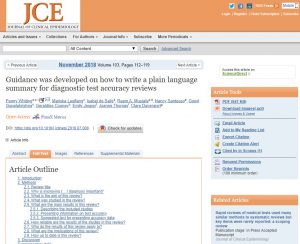Improving plain language summaries of Cochrane diagnostic test accuracy reviews
We have developed a template and guidance on how best to summarise and explain the results of diagnostic (systematic) reviews in plain language.
Diagnostic tests, for example blood tests, X-rays and colonoscopies, are used to help detect diseases. Cochrane diagnostic test accuracy reviews summarise and bring together the evidence from a range of studies on a specific type of test.
These systematic reviews are important for assessing whether a diagnostic test is effective in medical practice. Users of diagnostic tests, including clinicians and patients, need to be able to easily understand the results of these reviews.
A plain language summary is a stand-alone summary of a systematic review and should provide rapid access to its content.
A clear plain language summary is essential to ensure that these reviews are useful to people who are not familiar with the more technical content of the review. Ideally, the summary should be accessible to all potential target audiences, including patients, clinicians, policy makers.
Cochrane is a non-profit, non-governmental organisation. Through its reviews, it organises medical research findings to support evidence-based choices about health interventions by health professionals, patients, and policy makers.
This work was supported by NIHR CLAHRC West and Sense about Science. It was funded by a research grant from Cochrane.
Project aims
Explaining the results of a diagnostic test accuracy review in plain language is challenging. The overall aim of this project was to develop a template and guidance for plain language summaries for Cochrane diagnostic test accuracy reviews.
What we did
The guidelines have been developed through close working with target audiences, including patients, journalists and clinicians.
We ran focus groups, which then fed into one-to-one user testing of our proposed guidance. We ran a web-based survey at the same time as user testing, to broaden participation from academics, clinicians, patients and journalists. We also held a public engagement event.
We worked closely with Cochrane throughout, including holding workshops with them.
What we found and what this means
Through our research, we have produced detailed guidance and a template for researchers who are writing Cochrane reviews of diagnostic tests. This includes patient-approved wording, suggested headings and an overall structure.
The guidance includes real world examples of findings written using them.
What next?
Cochrane will share the guidance with its authors, but it is also relevant and valuable for anyone conducting systematic reviews of diagnostic tests.
We will share our guidance with the wider academic community, so that anyone undertaking this kind of systematic review can benefit.
Paper

Guidance was developed on how to write a plain language summary for diagnostic test accuracy reviews
Read the paperLinks and downloads
- Diagnostic test accuracy reviews plain language summary guidance Download the guidance
Lead collaborators
- Clare Davenport, University of Birmingham
- Mariska Leeflang, University of Amsterdam
- Gowri Gopalakrishna, University of Amsterdam
- Isabel de Salis, University of Bristol
- Emily Jesper, Sense About Science
- Joanne Thomas, Sense About Science
- Nancy Santesso, McMaster University
- Reem Mustafa, McMaster University
- Geraldine Cooney